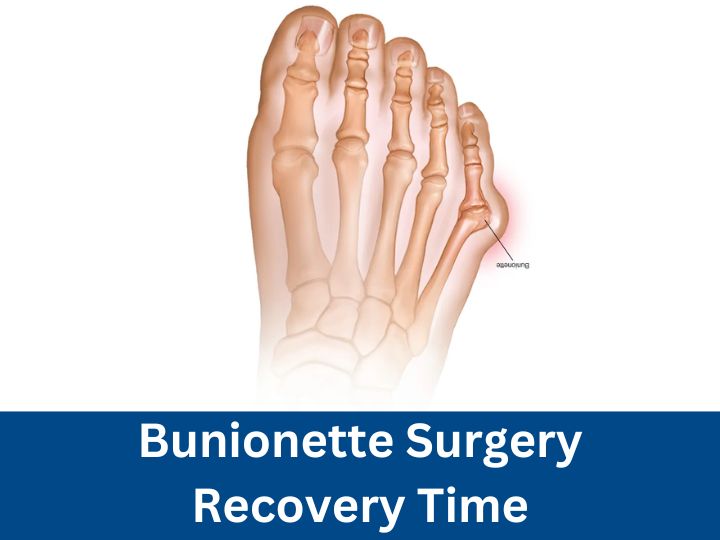Bunionette surgery recovery time can vary from a few months to a year, depending on several factors. The initial recovery typically takes 6 to 8 weeks, during which you should rest, elevate the foot, and avoid weight-bearing. After this period, you may use a special shoe or boot to aid mobility.
Full recovery, including the return to normal activities, can take 3 to 12 months, depending on surgery type, the severity of the condition, and individual healing. Following post-operative care and possibly engaging in physical therapy can help ensure a smoother and quicker recovery.
What is Bunionette Surgery?
Bunionette surgery is surgery to correct the deformity associated with a bunionette. Generally, the bony prominence needs to be removed, and the bones of the little toe realigned to restore normal foot function. This can be accomplished through various techniques, which include open surgery and minimally invasive approaches; each has its benefits and recovery implications.
Reasons for Surgery
Most patients undergo surgery when conservative treatments, such as orthotics, physical therapy, or anti-inflammatory medications, have failed to relieve them. Patients may choose surgery because of persistent pain, difficulty in wearing shoes, or limitations in physical activity from the bunionette.
Bunionette Surgery Recovery Timeline
The Bunionette Surgery Recovery timeline can help patients prepare mentally and physically for their post-operative journey. Recovery can be divided into several phases:
Initial Recovery Phase (0-2 Weeks)
The first two weeks after surgery are crucial for healing. During this period:
- Rest and Elevation: Patients are advised to keep their legs above the level of their hearts to reduce swelling. Rest is essential; patients should avoid putting weight on the operated leg.
- Wound Care: Proper care of the surgical site is essential to prevent infection. Patients should follow their surgeon’s instructions regarding cleaning and dressing changes.
- Pain Management: Pain and discomfort are common after surgery. Over-the-counter pain relievers or prescribed medications can help effectively manage pain.
- Stitch Removal: Depending on the surgical technique used, stitches can be removed between 10 and 14 days after surgery.
Early Recovery Phase (2-6 Weeks)
As patients transition into the early recovery phase:
- Gradually increasing activity: After about two weeks, patients should begin gentle range-of-motion exercises as advised by their surgeon or physiotherapist, if possible.
- Weight-bearing activity: Most surgeons allow partial weight-bearing on the foot using crutches or a walking boot two to four weeks after surgery.
- Protective footwear: Patients will likely need to wear a special shoe designed to protect the surgical site and maintain some mobility.
Mid Recovery Phase (6-12 Weeks)
During this phase, patients can expect:
- Improved mobility: Within six weeks, many patients can begin to walk more comfortably without crutches or walking boots. Swelling will begin to decrease.
- Physical therapy: Some patients may benefit from physical therapy to regain strength and flexibility in their legs. Therapists will guide them through exercises tailored to their recovery needs.
Full Recovery Phase (3-12 Months)
Full recovery can take anywhere from three months to a year, depending on individual circumstances:
- Long-term Expectations: Most patients notice a significant improvement in pain and mobility within three months. However, complete healing can take up to a year, and sometimes longer.
- Persistent Swelling: It is not uncommon for some swelling to persist for several months after surgery. Patients need to be patient as their bodies heal.
Factors Influencing Recovery Time
Several factors can influence how quickly a patient recovers from bunionette surgery:
- Severity of Deformity: More complex cases may require extensive surgical intervention, leading to longer recovery times.
- Type of Surgical Procedure: Minimally invasive techniques often result in quicker recoveries than traditional open surgeries due to less tissue damage.
- Individual Patient Factors: Age, overall health, and adherence to post-operative care play significant roles in recovery speed. Younger patients with no underlying health conditions generally heal faster.
Post-Surgery Care Tips
To ensure a smooth recovery process, consider these tips:
- Keep Foot Elevated: Elevating the foot helps reduce swelling and promotes blood circulation.
- Follow-Up Appointments: Regular check-ups with your healthcare provider are essential for monitoring healing progress.
- Gradual Return to Activities: Listen to your body; avoid rushing back into high-impact activities too soon.
- Use Ice Packs: Applying ice packs can help manage swelling and discomfort during the initial recovery phase.
Common Questions About Bunionette Surgery Recovery
How Long Before Returning to Work?
The timeline for returning to work varies based on job requirements. For sedentary jobs, patients might return within 1-2 weeks; however, those with physically demanding jobs may need 6-8 weeks or more before resuming full duties.
When Can Normal Footwear Be Worn?
Most patients can transition back to normal footwear around 6-12 weeks post-surgery, but it’s essential to choose comfortable shoes that provide adequate support during this transition period.
What Are Signs of Complications During Recovery?
Patients should be vigilant for signs of complications such as excessive swelling, redness around the incision site, fever, or increasing pain that does not respond to medication. If any of these symptoms occur, it’s crucial to contact your healthcare provider immediately.
Conclusion
The recovery time for bunionette surgery is something one would want to know when considering this procedure. Understanding what each phase of recovery entails the initial rest and elevation to the gradual increase in activity one to be better prepared for a successful journey of healing. Always consult with your healthcare provider for personalized advice tailored to your specific situation.




